Using jewels as a means of conveying covert messages
was but one way of sending secret signals employed by our forbears. In the
eighteenth and nineteenth centuries, a secret language developed that made use
of a ubiquitous fashion accessory – the fan.
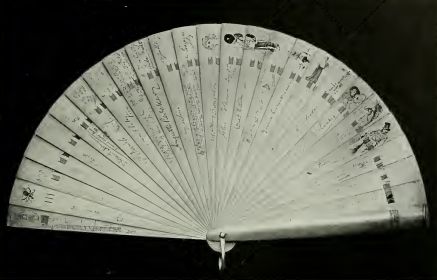 |
| An Autograph Fan |
Fans were used for far more than
simply keeping cool or swatting away the odd flying insect; there were mourning
fans, fortune telling fans, autograph fans, riddle fans, political fans,
programme fans and many, many more.
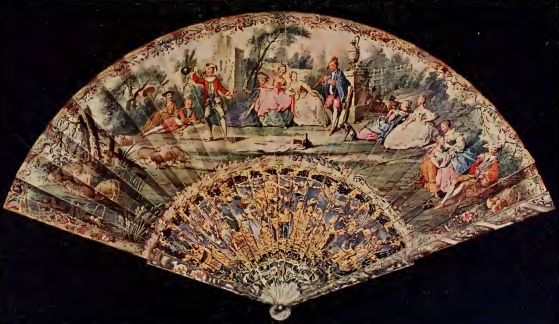 |
| French Fan c.1750 |
Opera and theatre fans may have been decorated
with bars of music, lyrics or scenes from a play. Game fans bore the rules of a
game, with a coloured border of playing cards. Fans were produced to celebrate
royal births or marriages. Fans featuring portraits of favourite preachers, and
verses and illustrations from the Bible enlivened Church services.
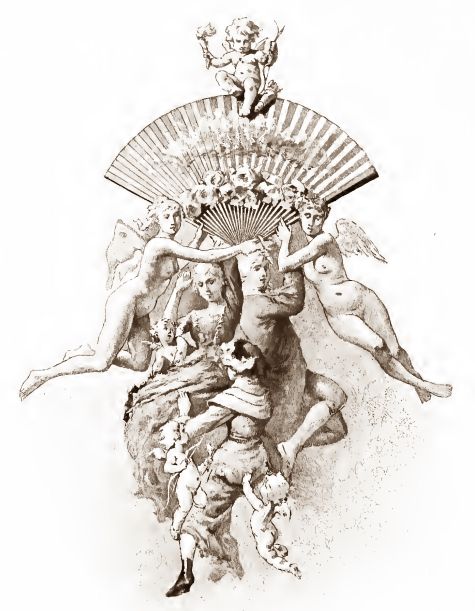 |
| Heavenly Fans |
There were
fans of starched lace, feathered fans, silk and taffeta fans, jewelled fans,
kid leather fans, painted fans and printed fans, gold and silver fans, plain
fans, fancy fans, paper fans, folding fans, fluttering fans; in short, fans of
every sort, for every occasion, were everywhere.
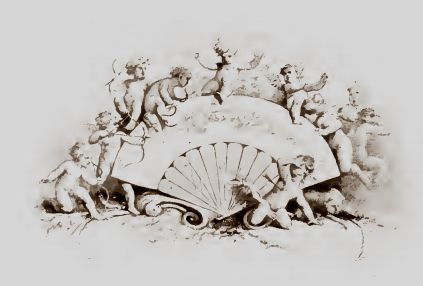 |
| Cherubs and Fan |
The fan could be used simply
as a means of showing support for a cause, faction or party, just through the
colours or an illustration, rather like those used today to display one’s
support for a sports team or popular band, but there was another way that
depended on how the fan was held and used.
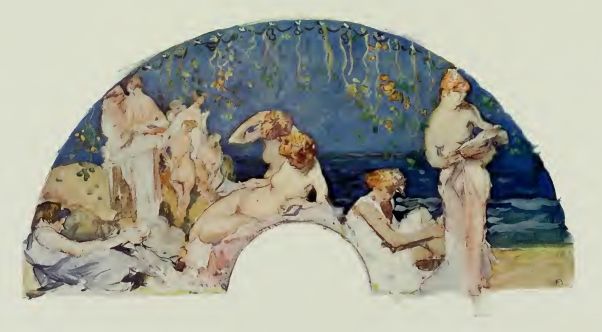 |
| Frank Brangwyn - The Blue Fan - Silk |
At its simplest, this could be
something as obvious as holding a closed fan to the right cheek, conveying
assent or ‘Yes’, and the reverse message, ‘No’ was sent by
holding the closed fan to the left cheek.
 |
| This Lady says Yes |
Joseph Addison, writing in The
Spectator of June 27th 1711, says,
“Women are armed with Fans as men with Swords—and sometimes do more execution with them . . . There is an infinite variety of motions to be made use of in the flutter of a Fan. There is the angry Flutter, the modest Flutter, the timorous Flutter, the confused Flutter, the merry Flutter, and the amorous Flutter … I need not add that a Fan is either a Prude or Coquette according to the nature of the person who bears it!”
 |
| Joseph Addison |
As may be expected, this language quickly grew, with specific gestures
used to send specific messages. A closed fan placed near the heart meant, ‘You
have won my love’, a closed fan resting on the right eye meant, ‘When
may I see you?’, the number of sticks folded out from the fan indicated the
hour. Drawing a fan across the cheek said, ‘I love you’, drawing a
closed fan through the hand said, ‘I hate you’. Clasping the hands
beneath an open fan, ‘Please forgive me’; covering the left ear with an
open fan, ‘Do not betray our secret.’
 |
| The Ubiquitous Fan |
Closing the fan whilst fanning
oneself slowly meant, ‘I am married’, doing the same whilst fanning
oneself quickly meant, ‘I am engaged’, closing the fan quickly and
impetuously meant, ‘I am impatient’, slowly and deliberately closing a
fully opened fan meant, ‘I promise to marry you’. Dropping the fan, ‘I
belong to you’, pressing a half-opened fan to the lips, ‘You may kiss me’,
pressing a fully-opened fan to the lips, ‘I don’t trust you’, twirling
the fan in the right hand, ‘I love another’, twirling the fan in the
left hand, ‘We are being watched’.
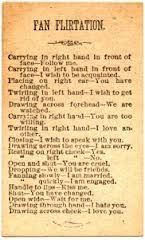 |
| Fan Flirtation |
The famous Parisian fan-maker, Maison
Duvelleroy, even went so far as to present the purchasers of their new fans with
a little printed card that gave a brief outline of the code. Which, of course,
meant that everyone who bought a fan was in on the secret, and as Duvelleroy’s
sold hundreds of thousands of fans, so hundreds of thousands of people made the
secret code something less than secret. It was a gimmick, a selling point, and
buyers love to believe that they are members of a small group of cognoscenti,
belonging to an elite, select minority.
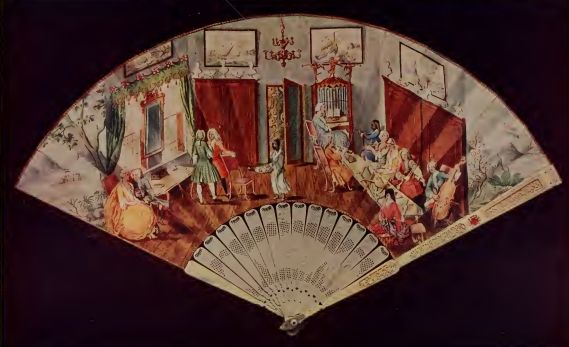 |
| Dutch Theatre Fan c.1730 |
Now if the whole of Europe is busy
fluttering its fans, flapping and twirling and dropping the things across the
continent, there will be occasions when a message got through, under the radar,
so to speak, of an inattentive chaperon, but all in all, it was a bit of fun
and not really meant to be taken seriously. It was not unlike modern B1ff or
1337-speak (again, LEET derives from ‘elite’, also a manifestation of a
secret coding in-crowd), which can be impenetrable to teh n00bs, but is plain
when U R pwnage & AYB.
 |
| AYBABTU |
There were other fan-messaging languages that were
used, the simplest of which had the letters of the alphabet printed onto the
folds of the fan and all that needed to be done was to spell out words by
displaying the individual letters, something which is, again, hardly secret
when flashed across a crowded salon. It also implies a remarkably high level of
eyesight in the gentlemen of old.
 |
| The Parts of a Fan |
A more contrived method is more akin to
semaphore signalling, as the alphabet is split into five groups of five letters
(‘J’ was omitted), with five movements within each of the five subdivisions –
ABCDE FGHIK LMNOP QRSTU VWXYZ. These five movements were: 1 with the left hand
to the right arm, 2 with the right hand to the left arm, 3 to the bosom, 4 to
the lips and 5 to the forehead. Let’s say you wanted to send the word DEAR, so
to begin, the fan is moved onto the right arm, signifying the first group of
five letters (ABCDE), and then to the lips, signifying the fourth letter within
that group.
 |
| Try doing this with a fan ... |
To make ‘E’, the fan is move back to the right arm, then to the
forehead, signifying the fifth letter in the first group. ‘A’ is next, again in
the first group, so it’s onto the right arm again, and the gesture is repeated
to indicate the first letter of the group. Finally, ‘R’ is made by signalling
the fourth group of letters, so the lips are touched with the fan, and then
moving the fan onto the left arm indicates the second letter of that group.
When the whole word has been spelled out, the fan is opened fully, to signal
that the word has been completed.
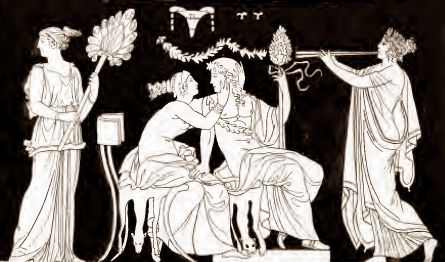 |
| Ancient Greek Fan |
Personally, I’d say a little written note, passed
surreptitiously from hand to hand, would be far less bother than all this
rigmarole, and far less open to misinterpretation, but then again, that lacks
the underlying frisson of the forbidden.
 |
No comments:
Post a Comment